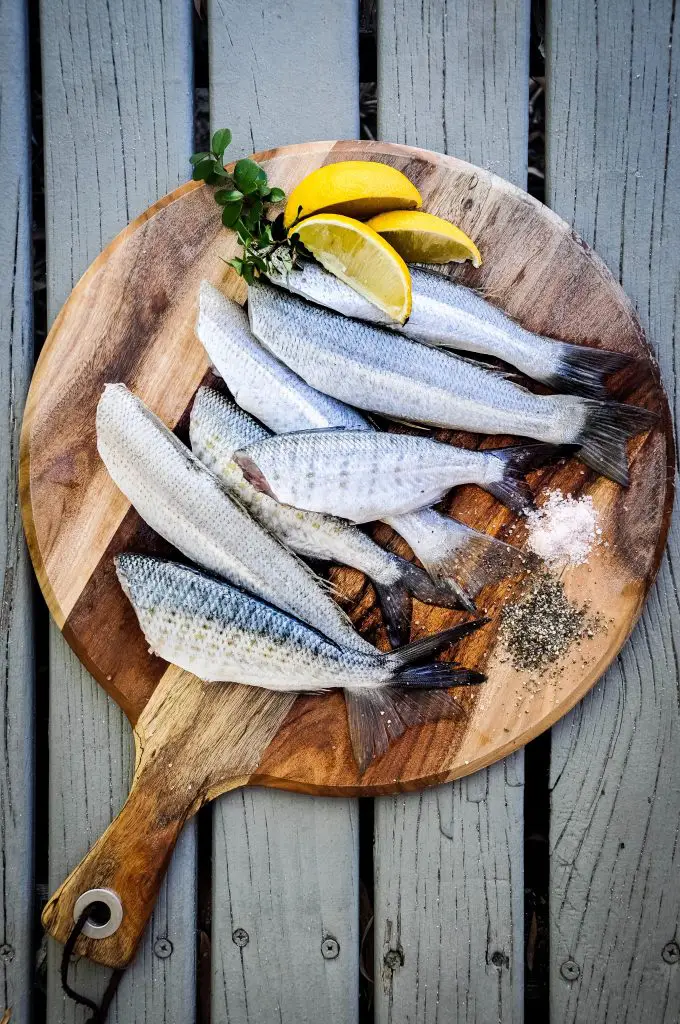As an Amazon Associate we earn from qualifying purchases.
Fish tastes bad – and if you’re reading this, you or someone you’re cooking for knows that for a fact. But there are ways to make fish taste better by getting rid of its characteristic pungent taste.
I’ve highlighted the best cooking techniques on the internet so you can learn how to cook fish so it doesn’t taste fishy.
Quick Navigation
How to Cook Fish so It Doesn’t Taste Fishy
Making fish taste good and not taste fishy is a lot simpler than you’d think.
Learn to Prep the Fish Right
The secret behind removing the fishy flavor from fish is to learn the correct way to prep the fish. To remove the lingering pungent flavor from any fish:
Step #1: Soak the Fish in Milk
Find a bowl that fits the fish, place the fish in the bowl, and add milk to the bowl till it covers the fish.
While you can use any type of milk for this, using buttermilk as an ingredient is the most effective way of removing the fishy taste.
Leave the fish in the milk for 15 minutes. Then drain the bowl and rinse the meat with water.
Step #2: Treat the Fish With Salt
Grab another bowl, and fill it with enough cold water to submerge the fish. For every cup of water you add, add two tablespoons of salt, sugar, and lemon juice, then mix.
Gently transfer the fish to the new bowl, and then transfer the bowl into the fridge.
Let the fish soak in the concoction for one hour. After an hour passes, drain the bowl and rinse the fish with water.

Step #3: Remove the Oil With a Dry Rub
The oil in the fish is one of the main things that gives it the pungent flavor. Getting rid of the oil is easy – all you have to do is make mix equal parts salt and sugar, and rub the mixture into the fish.
After rubbing the mix in, leave the fish in the refrigerator for about half an hour. The oil will drip out into the bowl or plate you’ve placed the fish in.
If you see a lot of oil seeping out of the fish after thirty minutes, rinse the fish, pat dry it, and rub the mix into the fish again before putting it back in the fridge.
If there’s still a lot of oil seeping out of the fish, you can repeat the process a third time. Do not dry rub the fish with the mix more than thrice since it will start affecting the consistency of the fish.
If there is little to no oil seeping out of the fish after the first dry rub, the fish is ready to cook.
Incorporate Lemon Into the Dish
Cooking fish with lemon will not only complement its flavor but also mask any of the remaining fishy flavor. If you have an extremely oily fish at hand, the lemon may not completely mask the taste. But it will make it a lot easier to eat.
If you’re sensitive to the taste of fish but want to eat it for its health benefits, marinade the fish in lemon juice before cooking it.
You can fry fish with lemon juice and butter, or if you want to deep fry fish, you can squeeze some fresh lemon juice on top to help with the savory flavor.
Be open to trying any of the hundreds of lemon-based fish recipes on the internet. Pick anything that sounds interesting since the aforementioned prepping technique will get rid of most – if not all – of the fishy taste from the fish.
—
Tip!
Find and cook fresh, white fish. Studies show that fresher fish smells and tastes less pungent. White fish have less oil and hence don’t taste as fishy.
—

Mask the Flavor With the Right Herbs
After lemon, herbs are the best tools you have to balance the fishy flavors in the fish. Some of the best herbs you can use when cooking fish include:
- Bay leaves: The unique scent of bay leaves can lift the flavor of delicate fish like Tilapia and Cod effectively. You can also use these if you’re cooking chowder or fish soup.
- Dill: While many consider Dill a basic herb, adding it to fish can give its flavor new life. It goes well with any type of seafood, adding a delicate twist of flavor to whatever it’s added to.
- Chives: You can add Chives to virtually any dish. You can add it to the compound butter that you fry the fish in or incorporate it into the marinade to give it a pleasant garlicky flavor. The herbs also work great if used as a simple garnish to complete your fish dish. The mild garlic-y notes make fish a lot more interesting.
- Mint: This herb can be your saving grace if you’re afraid the fish still tastes fishy. Mint works like magic in cutting through the sharp flavor of fish and gives the food a satiating tang. That being said, it must be used with care since it can overpower a dish easily.
- Sage: The herb has an earthy, peppery flavor and is undoubtedly one of the best herbs to use if you want your dish to have some bold notes. Since it can overpower the dish quite easily, you must use it sparingly.
Frequently Asked Questions
What kind of fish doesn’t taste fishy?
Tilapia, Cod, Flounder, Haddock, Arctic Char, and Grouper are some of the best fish to buy if you’re looking for fish that don’t taste fishy. Salmon and mackerel are fish you want to avoid since they taste the fishiest.
How to figure out if a fish is fresh?
As mentioned earlier, fresh fish taste a lot less fishy than older fish. As reported by the FDA, fresh fish has clear, bulging eyes and firm, shiny skin that bounces back when pressed down. If the fish smells like ammonia, it’s not fresh. Only buy fish if it smells mild.
The Takeaway
With all of these new tricks up your sleeve, you’ll be able to enjoy fish without its fishy flavors.
After you use these techniques in the kitchen, enjoy your fish with a nice cold margarita or a cucumber cooler.
